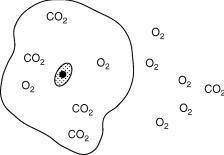
The accompanying diagram represents a cell in water. Formulas of molecules that can move freely across the cell membrane are shown. Some molecules are located inside the cell and others are in the water outside the cell.
PLEASE SELECT
Based on the distribution of these molecules, what would most likely happen after a period of time?
A .The concentration of O2 will increase inside the cell.
B .The concentration of CO2 will remain the same inside the cell.
C. The concentration of O2 will remain the same outside the cell.
D. The concentration of CO2 will decrease outside the cell.


Answers: 3
Another question on Chemistry

Chemistry, 22.06.2019 18:10
The atom fluorine generally will become stable through the formation of an ionic chemical compound by accepting electron(s) from another atom. this process will fill its outer energy level of electrons.
Answers: 1

Chemistry, 22.06.2019 22:30
Vi limitens. vastery test select the correct answer. which statement explains why large atoms are more reactive than small atoms? a. large atoms have valence electrons farther from the nucleus and lose them more readily. b. large atoms have greater ionization energy, which they can utilize during a reaction. c. large atoms have a greater number of electrons that they can lose during a reaction. d. large atoms have more energy levels, so they have more energy to pass on in a reaction. reset next
Answers: 3

Chemistry, 23.06.2019 02:30
Asubstance is held in an open container. its particles move past one another at random speeds but do not leave the container. heat is removed from the system, and the particles slow down. when enough heat is removed, the particles no longer have enough speed to overcome the weak attractive forces between them. when this happens, the substance enters its solid state. the process described above is known as .
Answers: 3

Chemistry, 23.06.2019 05:00
C=59(f−32)the equation above shows how temperature f, measured in degrees fahrenheit, relates to a temperature c, measured in degrees celsius. based on the equation, which of the following must be true? a temperature increase of 1 degree fahrenheit is equivalent to a temperature increase of 59 degree celsius.a temperature increase of 1 degree celsius is equivalent to a temperature increase of 1.8 degrees fahrenheit.a temperature increase of 59 degree fahrenheit is equivalent to a temperature increase of 1 degree celsius.a) i onlyb) ii onlyc) iii onlyd) i and ii only
Answers: 1
You know the right answer?
The accompanying diagram represents a cell in water. Formulas of molecules that can move freely acro...
Questions

Social Studies, 02.10.2020 23:01


Mathematics, 02.10.2020 23:01

Mathematics, 02.10.2020 23:01

Mathematics, 02.10.2020 23:01








Advanced Placement (AP), 02.10.2020 23:01




History, 02.10.2020 23:01

Mathematics, 02.10.2020 23:01


Mathematics, 02.10.2020 23:01



